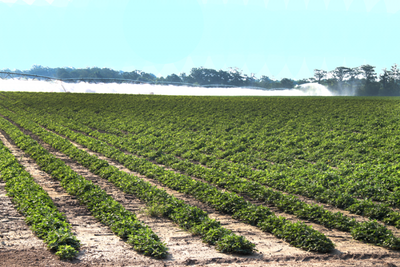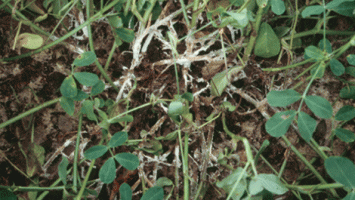
PeanutFARM (Field Agronomic Resource Manager), a group of tools to allow growers to manage peanut development and maturity, uses temperature and rainfall/water data to determine optimum peanut harvest time. "It can eliminate a lot of the judgment calls involved in the present methods of pod blasting and profile boards,” says Jason Sarver, Mississippi State University peanut specialist.

New technology may soon allow Mid-South peanut growers to make decisions on irrigation scheduling and digging with greater accuracy and ease.

JASON SARVER
PeanutFARM (Field Agronomic Resource Manager), a group of tools to allow growers to manage peanut development and maturity, has been in development for several years by University of Florida researchers, says Jason Sarver, Mississippi State University Extension/research professor, who spoke at the Mississippi Farm Bureau Federation’s summer peanut commodity meeting. Sarver assumed the peanut specialist post in January.
“It works as an irrigation scheduler, but perhaps more importantly for us, it uses temperature and rainfall/water data to determine optimum peanut harvest time. It can eliminate a lot of the judgment calls involved in the present methods of pod blasting and profile boards.”
STAY CURRENT on what's happeningin Mid-South agriculture: Subscribe to Delta Farm Press Daily.
The system tracks adjusted growing degree days (aGDDs), using upper and lower daily air temperatures, plus the amount of water the crop receives from rainfall and irrigation, to predict development of the crop. In addition to tracking peanut maturity, aGDDs are used by PeanutFARM to help schedule irrigation by estimating crop canopy cover and daily water use.
This daily water use is then modified using weather data — which can be automatically drawn from state networks or input for individual fields, depending on grower preference. As the grower develops his/her own profile, each field can be managed separately and processed by PeanutFARM to accurately predict the need for irrigation and optimum harvest time.
“The purpose of PeanutFARM is to provide a producer with tools to ease both in-season and harvest management decisions,” Sarver says.
System ‘works really well’

Once past the cool, wet planting season and peanuts emerged, the crop made good progress.
“We have an automated weather system in Mississippi that can tie in with PeanutFARM to provide needed data, or a grower can input field location, temperatures, and rainfall, and at end of season it will tell when crop is mature and ready to dig. The Florida team has done a lot of work with the system, and it works really well — in many cases better than pod blasting and profile board. If we can get beyond having to blast peanuts, it will save growers a lot of effort and judgment calls in determining when to dig.
“Hopefully, by 2015, we’ll have Mississippi’s automated weather network linked into this system, ready for growers to use. I think this is going be a really good tool for our growers, and funding is in place to get it up and running.”
In discussing this year’s Mississippi peanut crop, Sarver says, “Once we got past the cool, wet planting season and peanuts emerged, things were pretty quiet through mid-July.
DON'T MISS IMPORTANT EVENTS: Delta Farm Press Calendar of Events
“We had a lot of seed go in the ground this spring when it probably shouldn’t have. I had many calls from growers telling me, ‘My seed just aren’t coming up.’ This was primarily due to planting in soils with temperatures in the low 60s or below, compared to the recommended range of 68-70 degrees.
“After planting in those conditions, things were compounded by a cold snap and rain, and a lot of seed just sat in the ground for a long time. I was impressed with how well it did under such adverse circumstances.
“We had some very spotty stands, and in many cases, it took four weeks to get a decent stand. That’s something we’re going to have to consider this fall — that we’ve got April 15-planted peanuts that didn’t come up until about May 10, so it will be more in line with a May 1-planted crop than an April 25-planted crop. We’re going to have to monitor this as harvest time approaches.
Damage by wild hogs
“There were situations where water stood on fields, and growers had to go in and plant more seed; areas on ridges had better emergence than lower places where water stood. Then, to add insult to injury, some growers had damage by wild hogs. I’ve seen quite a bit of that this year.”
Some growers had situations with peanut yellowing and plants not growing well, Sarver says. “In a couple of places where inoculants were misapplied, they had to add some ammonium sulfate or urea to get a little nitrogen to the plants. In most cases, though, it was due to the crop going through a period of not having enough sunlight and too much water on the roots. Bacteria in the root zone need oxygen in order to nodulate and fix nitrogen, so that’s where most of the issues occurred. After the sun came out and things dried out, the plants really took off.
“In a handful of places, there were misses with preemerge herbicides in some passes or parts of fields, and weed problems occurred. Sometimes I think we take our pre-herbicides for granted, and this kind of situation shows how important they are.”
In a lot of areas, Sarver says, there was too much rain early season, “but during the pod filling period adequate water is critical — from 50 days to 110 days after planting is the key pod fill period, and that’s when water can make or break this year’s crop. All the early rain resulted in a fairly shallow-rooted crop, so if late summer and early fall are dry, we could be looking at a crop with potential to suffer from lack of water.
Inadequate water limits yield
“For a May 1-planted crop, if it emerged relatively quickly, it needs about a quarter-inch of water per day right now in order not to be water-limited. For May 15 – and later-planted peanuts, about three-quarters inch to 1 inch of water is needed per week at this point. Some people say, ‘Well, peanuts don’t need a lot of water,’ but in reality if we look at water use graphs, if the crop’s fairly high water use needs aren’t met, it will limit yield.”
While insects in other crops “have exploded this year,” Sarver says at mid-season they were light in peanuts.

WHITE MOLD began appearing in some peanut fields in late July.
White mold (stem rot) disease is always a major concern for peanuts, he notes, “but at mid-July, we hadn’t seen any.” False white is showing up as well, he says, “but it is superficial and nothing to worry about. To tell the difference, with white mold there will be rotten stems and wet stems underneath the fungus, but with false white mold the stems underneath will be green. There’s no need to control false white mold, so don’t worry about it. In fact, there is some work in the southeast using false white mold as a biological control method.”
[Two days after the meeting, Sarver said later, “We got our first reports of white mold/stem rot. Alan Henn, Extension professor of entomology and plant pathology, and I traveled from the Tchula area to Clarksdale and found some level of the disease throughout that range. Growers started intensive programs to control the disease.”]
The National Agricultural Statistics Service reports 40,000 acres of peanuts in Mississippi this year, Sarver says, “but I think it’s closer to 37,000 to 38,000.”
About the Author(s)
You May Also Like



